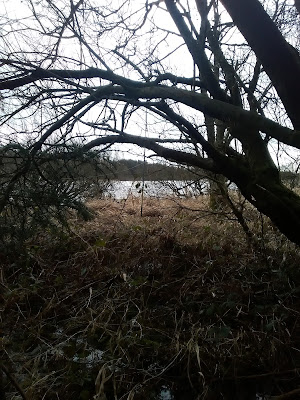No overnight WSPR reception diary today. We have had wind and some snow, but also occasional lightning, so antennas disconnected!
It's getting windy again up here on the western fringes of Wales (110km/h overnight!) Together with the developing urge to move house, I am turning a lot of attention to getting out for walks and deploying WSPRlite in various places. Eventually, I hope to listen and send /P.
 |
| New portable operating location. |
I was brought up very close to a lake - Llyn (Lake) Cefni, in the middle of the island, actually a man-made, very shallow water supply reservoir built in the late 1950s. So I spent most of my childhood getting very muddy and knowing the place very well. I thought it might be an interesting place to set up a 1/4 wave in the water-saturated ground by the water, and see how it goes.
At lunchtime, I went for a quick walk, got my feet very wet, but managed a very easy deployment of the 1/4 wave vertical. A drainage pipe with some warm fabric keeps the battery and WSPRlite fairly happy and dry. Because of very strong winds, I tied the fishing pole to a nearby tree branch, just in case.
 |
| Can you see it? |
The land to one side of the lake rises gently, and has a lot of tall coniferous trees in a dense, man-made plantation arrangement. I thought this might reduce the signal to the WNW considerably. In fact, the signals compared quite favourably, at least until the very low angle signals to the US were lost to the lakeside vertical. Otherwise, it compared pretty well.
 |
| Afternoon run, 16/01/2018 |
 |
| MW1CFN (copper mine) minus MW6PYS (lake side) |
When considering all spots, across all distances, the lake vertical is nearly 3dB better (on the next day, this increased to greater than 4dB) than my copper mine vertical. I don't present a graph just yet, but when the spots beyond 3000km were examined (only two spots, hence it can't be relied upon yet), the difference was only just over 1dB between the two (later rising to 4dB better for the more open, copper mine site) despite the significant reduction in low-angle availability and the signal-degrading potential of trees to vertical radiation for the lake antenna.
Day 2.
Both antennas were essentially keeping pace with one another, espeically in the early few hours of the morning - a result of the land being free of trees and flat from NE to SSW:
The lake was beating the home QTH by a good margin of nearly 4dB:
The story was reversed, a result of the trees and less favourable ground to the west, when considering distances beyond 3400km. Not the home QTH vertical is about 2.6dB better (sorry, I cut off the number, but you can see by eye how it works):
And in terms of DX achieved, well, there is not much to choose between them, both reaching the same maximum distance (curiously, the software reports a slight difference in maximum distance):
The results are quite surprising in that the home QTH has a much more open overall environment than the lake location, yet both antennas perform equally well until propagation swings more to the west.
The lake vertical did much better to V51PJ, in that it received 21 spots from that station over the preceding 24 hours, at a median S/N of -24dB. The home QTH vertical only managed 5 spots, at a median -26dB S/N. A salutary lesson in not rushing to too hasty a conclusion when the signal strength difference is superficially trivial.
Again on a southerly path, DP0GVN heard the home QTH vertical five times, at a median S/N of -23, whilst the lake vertical was heard four times, at a median S/N of -21dB.
The local terrain to the south, until it reaches sea, looks like this for each antenna, with the lake at the top, home QTH at bottom. Even though the terrain looks considerably worse for the lake vertical in the near distance, and that we might initially expect the sharper mountain peak to provide better ray diffraction to lower angles, the lake does, nevertheless, appear to do consistently better in that direction:





1 comment:
Hello John, just disconnected the WSPR station here as I want to work some "DX" ;-) Saw I had a reasonable steady path from both you and Ella her callsign. 73, Bas
Post a Comment